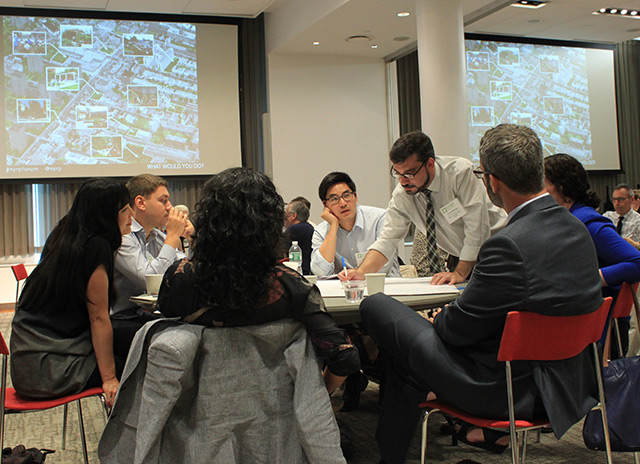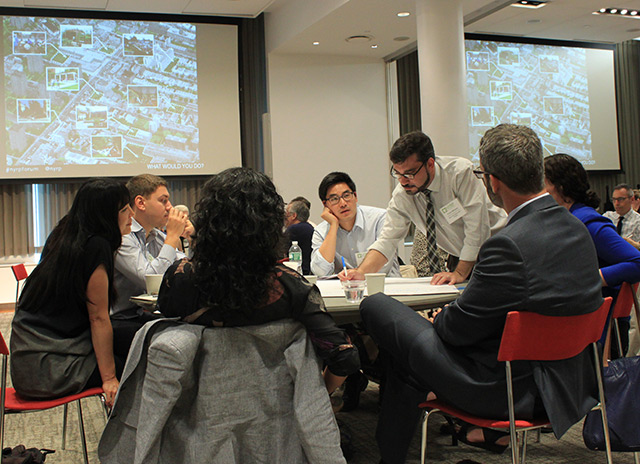
Public-private partnership could transform Charlotte, N.C.
Photo: Charlotte Community leaders in a workshop last Friday with New York Restoration Project. Photo credit: Ellen Xie, New York Restoration Project.
With a population of just under 800,000, Charlotte, N.C., is a fraction of the size of New York. But Knight Foundation is betting that a novel neighborhood transformation project in the Big Apple can become a model for similar projects in the Queen City – and possibly other Knight communities around the country.
Related Link
“Charlotte, N.C., team kicks off shadowing project to build better neighborhoods” by Dave Cable on Knight Blog
The multiyear parent project, Resilience in the Public Realm, kicked off Wednesday with a five-hour brainstorming session with more than 50 people with backgrounds ranging from architecture and urban planning to economic development and public health.
A smaller group will work over the next year planning how to improve all of the open spaces in a single New York neighborhood, including vacant lots, sidewalks, parks and playgrounds. Implementation is expected to take three to seven years.
“We’re looking at public open spaces as the matrix for all other services that could impact quality of life in a low-income neighborhood,” said Deborah Marton, executive director of the nonprofit New York Restoration Project, which is heading the project.
Knight Foundation is supporting the project’s planning and development phase with a $250,000 grant. It also is helping the nonprofit TreesCharlotte shadow the New York project team during the planning and development process.
The primary role of TreesCharlotte, a public-private collaborative, is to plant 15,000 trees annually to cover half of the rapidly growing city with trees by 2050.
The group’s executive director, Dave Cable, “is really great at developing really viable public-private partnerships,” said Susan Patterson, Knight’s Charlotte program director. The hope is that by participating in the Resilience in the Public Realm project, Cable will gather and share ideas that can help Charlotte become more vibrant and attractive to young professionals.
“I think Charlotte’s got a lot of potential, but we’re a little behind some cities in thinking of some of these things,” she said.
Cable said he appreciated that the brainstorming discussion in New York “wasn’t framed by a lot of guardrails.” He described a meeting with “PowerPoints, easels and sticky notes all over the place” as ideas flew.
In the first of four sets of discussions, multidisciplinary groups talked about how they would improve a high-need neighborhood if they could do anything they wanted. The next focus was what a neighborhood would look like five years after implementing the best ideas discussed in the first session.
Eight themes emerged, Marton said: safety, incubators to catalyze services and entrepreneurship, health, biodiversity, neighborhood ownership, community engagement, programming and radical rescaling of streets.
Then, single-discipline groups – Cable’s group was green space and environment – talked about how, where and with whom the ideas would be implemented.
Later, the entire group pondered “the known unknowns, and the unknown unknowns.”
Marton said she was intrigued by discussion on how to involve a community in determining what actions and programs could most benefit their neighborhood, and by a suggestion to have communities compete to become the Resilience in the Public Realm neighborhood.
In Charlotte, Cable planned to meet soon with a small steering committee helping him get the local project off the ground. Members are Allison Billings, vice president for neighborhood development, transportation and sustainability for Charlotte Center City Partners; Carol Morris, vice president for community initiatives at Foundation for the Carolinas; and John Kinley, a planner for the city of Charlotte.
Some of that core group will likely accompany him to New York on what could become monthly trips, he said. They’ll also form the core of a larger project group that will work on Charlotte’s neighborhood project, which has not yet been selected.
Julie Bird is a Charlotte-based writer.
Recent Content
-
Community Impactarticle ·
-
Community Impactarticle ·
-
Community Impactarticle ·



